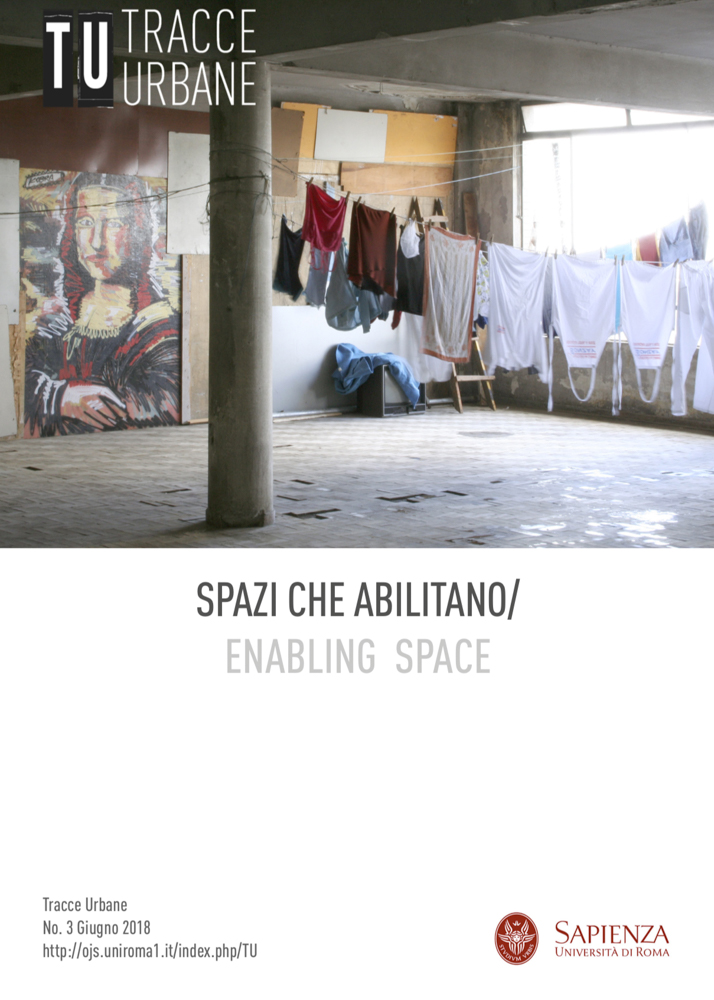Self-Organization in Rome: a map
DOI:
https://doi.org/10.13133/2532-6562_2.3.14281Parole chiave:
Self-organization, Mapping, Urban policiesAbstract
During the last years many different researches regarding social spaces have been realized in Rome, sometimes containing different maps representing these experiences. Nevertheless, these processes are very dynamic and the situation of Rome changes every year. For this reason in November, 2017 we decided to realize, during the International Conference "Cities and Self-organization” held in Rome on December 2017, an updated map of all the self-organization experiences within the city of Rome in order to better understand the reach and the meanings of this phenomenon.
The main questions at the base of the present research are: why, even though these spaces are so copious, are not they able in influencing urban policies? Why are they concentrated mainly in some specific quarters of the city? What are their features compared to others European cities? To what extent are they able to change the public institutions?
Riferimenti bibliografici
Aureli A., Mudu P. (2017), “Squatting: reappropriating democracy from the state”, in Interface: a journal for and about social movements, Vol. 9 (1), pp. 497-521
Caritas (2017), La povertà a Roma. Un punto di vista, http://bit.ly/2G0XlUA(last access: 23th March 2018)
D'Albergo E., Moini G., Pizzo B. (2016), “Cosa vuol dire Metropolitano a Roma? Ambiguità spaziali, economiche e politiche” in Cellamare C., Fuori Raccordo. Abitare l’Altra Roma, Donzelli Editore
Fernandez-Kelly P., Garcia A. (1989), “Informalization at the core: Hispanic women, homework and advanced capitals state” in Portes A., Castells M. and Benton L. (Eds). The informal economy: Studies in Advanced an Less Developed Countries, Baltimore: Johns Hopkins University Press, pp. 247-264
Marinaro D. (2014), “Evicting Rome's undesirables” in Global Rome: Changing Faces of the Eternal City, Clough Marinaro I., Thomassen B., ed., Indiana University Press
Mudu, P. (2014a), “Housing and Homelessness in Contemporary Rome”, in Global Rome: Changing Faces of the Eternal City, Clough Marinaro I., ed., Thomassen B., Indiana University Press, pp. 62-78
Mudu, P. (2014b), “Where is the culture in Rome? Self-managed social centers and right to urban space”, in Global Rome: Changing Faces of the Eternal City, Clough Marinaro I., Thomassen B., ed., Indiana University Press, pp. 246-264
Mugnani L. (2017), “Attivisti, migranti e forme di lotta per la casa. La vita sociale di un ‘Coordinamento cittadino’ nella Roma contemporanea”, in Antropologia, Volume IV, n.3
Pisano M. (2013), Creare relazioni da abitare. Voci narrazioni, azioni in uno scheletro urbano riabitato, PhD thesis (PhD in Tecnica Urbanistica, DICEA, Sapienza University of Rome)
Pizzo B., Altavilla, E. (2018), “Embedding illegality, or when the illegal becomes licit” in The illicit and illegal in Regional and Urban Governance and Development, Chiodelli F., ed., Hall and Hudson.
Portes A., Castells M., Benton L. (Ed.) (1989), The informal economy: Studies in Advanced a Less Developed Countries, Baltimore: Johns Hopkins University Press, pp. 247-264
Pozzi G., Rimoldi L. (2017), “Marginal Uncertainties. Making a living and working in the outskirts of Milan”, Etno Antropologia, 5, 1, pp. 95-108.
Rao, U. (2013), Tolerated encroachment: Resettlement policies and the negotiation of the licit/illicit divide in an Indian metropolis, Cultural Anthropology, 28(4), 760-779, American Anthropological Association
Sassen S. (2010) (3rd edition), Le città nell'economia globale, Bologna, Il Mulino
Scandurra G. (2012), “La Corona di spine che cinge la città di Dio. Il caso del Pigneto”, Pompeo F., a cura di, Paesaggi dell'esclusione, politiche degli spazi, re-indigenizzazione e altre malattie del territorio romano, Novara: De Agostini scuola SpA
Scenari Immobiliari (Istituto indipendente di studi e ricerche) 2011, Global City Report
Sebastianelli, S. (2012), “Le occupazioni a scopo abitativo e le altre forme dell’abitare” Pompeo F., a cura di, Paesaggi dell'esclusione, politiche degli spazi, re-indigenizzazione e altre malattie del territorio romano, Novara: De Agostini scuola SpA
Tozzetti A. (1989), La casa e non solo. Lotte popolari a Roma e in Italia dal dopoguerra ad oggi, Roma, Edizioni Riuniti
Vereni P. (2013), “La porta di casa. Lo spazio domestico e di vicinato in una occupazione abitativa romana”, in Rotili M., Tedeschini M., Sensibilia 6. Cose, Milano-Udine, Mimesis, pp. 311-326
Vereni P. (2015a), "Cosmopolitismi liminari. Strategie di identità e categorizzazione tra cultura e classe nelle occupazioni a scopo abitativo a Roma", in ANUAC, vol.4, n.2
Vereni P. (2015b), “Addomesticare il welfare dal basso. Prospettive e paradossi delle occupazioni abitative romane”, in Meridiana. Rivista di Storia e Scienze Sociali, anno XVI, n.83, pp.147-169
##submission.downloads##
Pubblicato
Come citare
Fascicolo
Sezione
Licenza
NOTA DI COPYRIGHT
Proposta di licenza Creative Commons
1. Proposta per riviste Open Access
Gli autori che pubblicano su questa rivista accettano le seguenti condizioni:
Gli autori mantengono i diritti sulla loro opera e cedono alla rivista il diritto di prima pubblicazione dell'opera, contemporaneamente licenziata sotto una Licenza Creative Commons - Attribuzione che permette ad altri di condividere l'opera indicando la paternità intellettuale e la prima pubblicazione su questa rivista.
Gli autori possono aderire ad altri accordi di licenza non esclusiva per la distribuzione della versione dell'opera pubblicata (es. depositarla in un archivio istituzionale o pubblicarla in una monografia), a patto di indicare che la prima pubblicazione è avvenuta su questa rivista.
Gli autori possono diffondere la loro opera online (es. in repository istituzionali o nel loro sito web) prima e durante il processo di submission, poiché può portare a scambi produttivi e aumentare le citazioni dell'opera pubblicata (Vedi The Effect of Open Access).


